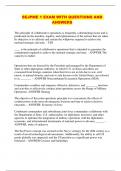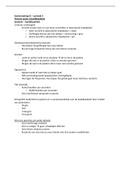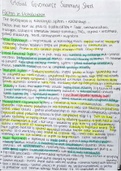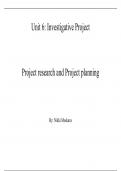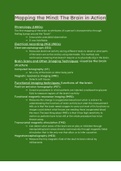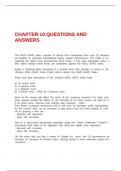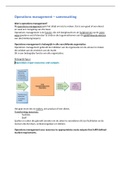Manual Gear Box
The aim is to familiarise a learner driver with the major visual components of a motor
vehicle. The intention is also to assist the learner driver to identify the controls that needs to
be used in conjunction to complete a certain manoeuvre or action.
The controls/components of a Light Motor Vehicle manual gear box is as follows...
1. Rear view mirror → used to see the rear of your vehicle.
• 2 Window wiper →used to clean the front windscreen of the vehicle and when driving in
the rain.
• 3 Left and right rear view mirrors → used to look what is on the right & left hand rear-
side of your vehicle
• 4 Steering wheel → used to change the direction of the vehicle ie. turning left or right or
keeping the vehicle on a straight path.
• 5 Indicator light switch →used to advise other road users of your intention to steer to the
left or right, or to turn to the left or right. (especially when changing lanes)
• 6 Gear level → used to change/select a gear
• 7 Hand brake →(Note that some vehicles might have the hand brake as a foot operated
control (e.g. Mercedes-Benz) used to ensure that your parked vehicle does not move. Also
used when parking and leaving a vehicle unattended.
• 8 Clutch Pedal → used when engaging or disengaging a gear or changing from one gear to
another.
• 9 Brake Pedal → used to stop your vehicle used to decrease speed or stop also used avoid
the vehicle stalling just before coming to a complete standstill.
When braking the distance it takes the driver of a motor vehicle to stop is
(i) longer on a wet road than on a dry road.
(ii) longer if the vehicle is travelling at a higher speed.
(iii) longer if the vehicle is loaded.
• 10 Accelerator Pedal → used to accelerate your vehicle. The speed of the vehicle can be
increased or decreased by this control.
• 11 Horn → used to alert other road users in order to avoid a collision
1
,Collisions do not occur at a certain time or place.
It usually occurs when one least expects it.
Very few collisions are caused by vehicle failure.
90% of all collisions are caused by driver neglect.
A vehicle can be a lethal weapon if not handled with care and attention.
Drivers face hazards on a daily basis.
A hazard: anything that could cause the change of speed or the change of the direction of a
motor vehicle.
Unfortunately it is a fact that drivers between the age of 18 and 25 are involved in more
accidents than drivers in any other group.
Always remember to be tolerant and patient when you drive a motor vehicle and always
remember that it can happen to you.
• To make driving a little easier, there are a number of rules one have to keep in mind.
DEFENCE DRIVING SYSTEM: SIPD
• Search (for hazards)
• Identify (the type of hazard)
• Predict (how one will be influenced by it)
• Decide (what action to take)
SEARCH
We should continually be searching for anything, which could cause us to change speed or
direction.
The search process should not be restricted to forward vision only, but to the sides and rear
as well.
One must bring all senses into action during the search for hazards especially the eyes.
It is essential for a driver to be aware of everything going on around him so that he can
react in the correct manner.
Certain hazards can be predicted under certain circumstances.
2
,At an intersection in an urban area there could be pedestrians, cyclists, motorcycles and
other traffic arriving from several directions in different lanes, which in turn may have
different road markings, and road signs that regulate your own and other's movements.
Remember you have to share the road safely.
Generally, where traffic meet or crosses presents the greatest danger.
There are various such intersections e.g. traffic circles, on - and off ramps on freeways,
hidden entrances to houses, traffic light controlled intersections, stop streets, junctions
where one must yield etc.
There are other situations, such as lane - changing and overtaking where maneuvers may be
prohibited.
When weather conditions are poor, one must consider how these could cause restricted
visibility and slippery surface, and the dangers flowing there from, especially with worn
tyres.
One must be aware that where the road narrows, e.g. where two lanes merge or where
vehicles are parked, someone may attempt to share the lane. One must predict the dangers
that may arise from these situations..
IDENTIFY
When a hazard has been identified during the search process the question should be asked:
Is it a stationary or a moving hazard and how will it affect my speed or direction.
PREDICT
Once the hazard has been identified, it is necessary to predict how it could affect you.
1) If the hazard can move, what are all the possible ways in which it can affect you?
2) Is the hazard moving away or towards or away from you, at what speed and where
can a collision occur?
3) What is the potential of the hazard for causing a collision?
4) How can you avoid the collision and influence other road users?
3
, DECIDE
Depending on your prediction, you must decide how to react to the situation.
Are you going to make your presence known by simply hooting or flicking the lights, should
you increase or decrease your speed?
Are you going to change direction only, or combine some of the above actions?
Your decision will be influenced by the amount of clear space you need to create between
your vehicle and the hazard.
Always create as much clear space for yourself as possible.
The importance of the SIPD (Search, Identify, Predict, Decide) process as part of the
System of Vehicle Control cannot be over emphasized.
Pedestrians bump into each other and apologise for not seeing each other. At the scene of a
collision, one frequently hears one of the drivers say: 'I did not see you'.
Many collisions could be avoided if drivers would only search for hazards, identify ;them,
predict the worst case scenario and then make the correct decision.
Many drivers approach a green light presuming that the red light for cross traffic will stop
them. Frequently, drivers do not obey the red robot!
Continually strive to create as much clear space as possible by adjusting speed or direction
so that you have more time and space in which to react to any hazard, especially at night.
RULES OF THE ROAD!!
RULES OF THE ROAD must be obeyed at all times, except in cases where a police officer or
traffic officer or a road sign indicates otherwise.
The rules of the road is a system that will allow road users to reach their destination
safely.
4


